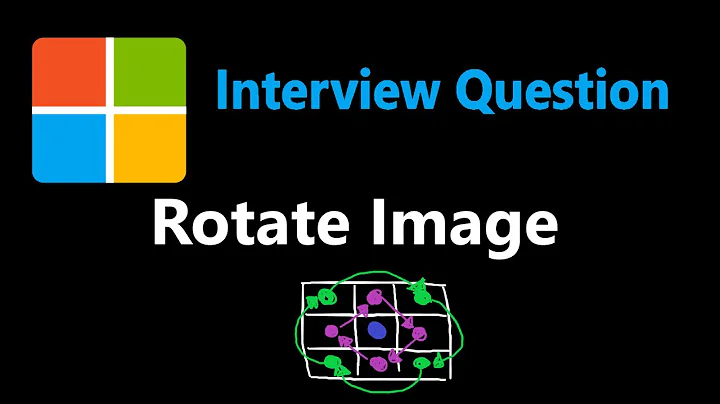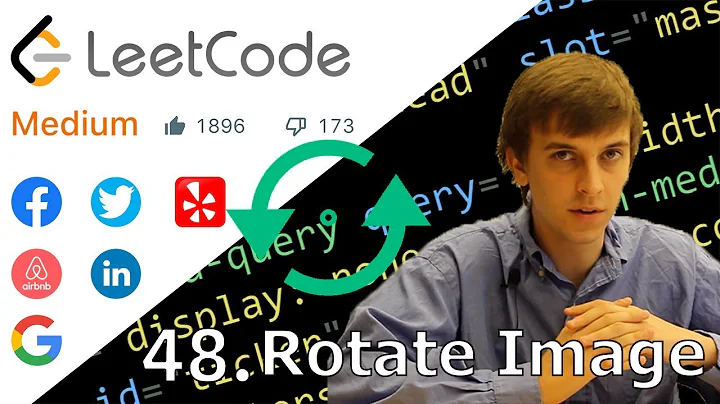How to efficiently rotate bitmaps in code
Solution 1
Yes, there are faster ways to do this.
Your simple loop spends most of the time in cache misses. This happends because you touch a lot of data at very different places in a tight loop. Even worse: Your memory locations are exactly a power of two apart. That's a size where the cache performs worst.
You can improve this rotation algorithm if you improve the locality of your memory accesses.
A simple way to do this would be to rotate each 8x8 pixel block on it's own using the same code you've used for your whole bitmap, and wrap another loop that splits the image rotation into chunks of 8x8 pixels each.
E.g. something like this (not checked, and sorry for the C-code. My Delphi skills aren't up to date):
// this is the outer-loop that breaks your image rotation
// into chunks of 8x8 pixels each:
for (int block_x = 0; block_x < 2048; block_x+=8)
{
for (int block_y = 0; blocky_y < 2048; block_y+=8)
{
// this is the inner-loop that processes a block
// of 8x8 pixels.
for (int x= 0; x<8; x++)
for (int y=0; y<8; y++)
dest[x+block_x][y+block_y] = src[y+block_y][x+block_x]
}
}
There are other ways as well. You could process the data in Hilbert-Order or Morton-Order. That would be in theory even a bit faster, but the code will be much more complex.
Btw - Since you've mentioned that SSE is an option for you. Note that you can rotate a 8x8 byte block within the SSE-registers. It's a bit tricky to get it working, but looking at SSE matrix transpose code should get you started as it's the same thing.
EDIT:
Just checked:
With a block-size of 8x8 pixels the code runs ca. 5 times faster on my machine. With a block-size of 16x16 it runs 10 times faster.
Seems like it's a good idea to experiment with different block-sizes.
Here is the (very simple) test-program I've used:
#include <stdio.h>
#include <windows.h>
char temp1[2048*2048];
char temp2[2048*2048];
void rotate1 (void)
{
int x,y;
for (y=0; y<2048; y++)
for (x=0; x<2048; x++)
temp2[2048*y+x] = temp1[2048*x+y];
}
void rotate2 (void)
{
int x,y;
int bx, by;
for (by=0; by<2048; by+=8)
for (bx=0; bx<2048; bx+=8)
for (y=0; y<8; y++)
for (x=0; x<8; x++)
temp2[2048*(y+by)+x+bx] = temp1[2048*(x+bx)+y+by];
}
void rotate3 (void)
{
int x,y;
int bx, by;
for (by=0; by<2048; by+=16)
for (bx=0; bx<2048; bx+=16)
for (y=0; y<16; y++)
for (x=0; x<16; x++)
temp2[2048*(y+by)+x+bx] = temp1[2048*(x+bx)+y+by];
}
int main (int argc, char **args)
{
int i, t1;
t1 = GetTickCount();
for (i=0; i<20; i++) rotate1();
printf ("%d\n", GetTickCount()-t1);
t1 = GetTickCount();
for (i=0; i<20; i++) rotate2();
printf ("%d\n", GetTickCount()-t1);
t1 = GetTickCount();
for (i=0; i<20; i++) rotate3();
printf ("%d\n", GetTickCount()-t1);
}
Solution 2
If you can use C++ then you may want to look at Eigen.
It is a C++ template library that uses SSE (2 and later) and AltiVec instruction sets with graceful fallback to non-vectorized code.
Fast. (See benchmark).
Expression templates allow to intelligently remove temporaries and enable lazy evaluation, when that is appropriate -- Eigen takes care of this automatically and handles aliasing too in most cases.
Explicit vectorization is performed for the SSE (2 and later) and AltiVec instruction sets, with graceful fallback to non-vectorized code. Expression templates allow to perform these optimizations globally for whole expressions.
With fixed-size objects, dynamic memory allocation is avoided, and the loops are unrolled when that makes sense.
For large matrices, special attention is paid to cache-friendliness.
Related videos on Youtube
Marco van de Voort
Fulltime Delphi devel (doing vision for a machine builder), and FPC devel in the evening.
Updated on July 27, 2021Comments
-
Marco van de Voort almost 3 years
Is there a faster way to rotate a large bitmap by 90 or 270 degrees than simply doing a nested loop with inverted coordinates?
The bitmaps are 8bpp and typically 2048x2400x8bpp
Currently I do this by simply copying with argument inversion, roughly (pseudo code:
for x = 0 to 2048-1 for y = 0 to 2048-1 dest[x][y]=src[y][x];(In reality I do it with pointers, for a bit more speed, but that is roughly the same magnitude)
GDI is quite slow with large images, and GPU load/store times for textures (GF7 cards) are in the same magnitude as the current CPU time.
Any tips, pointers? An in-place algorithm would even be better, but speed is more important than being in-place.
Target is Delphi, but it is more an algorithmic question. SSE(2) vectorization no problem, it is a big enough problem for me to code it in assembler
Follow up to Nils' answer
- Image 2048x2700 -> 2700x2048
- Compiler Turbo Explorer 2006 with optimization on.
- Windows: Power scheme set to "Always on". (important!!!!)
- Machine: Core2 6600 (2.4 GHz)
time with old routine: 32ms (step 1)
time with stepsize 8 : 12ms
time with stepsize 16 : 10ms
time with stepsize 32+ : 9ms
Meanwhile I also tested on a Athlon 64 X2 (5200+ iirc), and the speed up there was slightly more than a factor four (80 to 19 ms).
The speed up is well worth it, thanks. Maybe that during the summer months I'll torture myself with a SSE(2) version. However I already thought about how to tackle that, and I think I'll run out of SSE2 registers for an straight implementation:
for n:=0 to 7 do begin load r0, <source+n*rowsize> shift byte from r0 into r1 shift byte from r0 into r2 .. shift byte from r0 into r8 end; store r1, <target> store r2, <target+1*<rowsize> .. store r8, <target+7*<rowsize>So 8x8 needs 9 registers, but 32-bits SSE only has 8. Anyway that is something for the summer months :-)
Note that the pointer thing is something that I do out of instinct, but it could be there is actually something to it, if your dimensions are not hardcoded, the compiler can't turn the mul into a shift. While muls an sich are cheap nowadays, they also generate more register pressure afaik.
The code (validated by subtracting result from the "naieve" rotate1 implementation):
const stepsize = 32; procedure rotatealign(Source: tbw8image; Target:tbw8image); var stepsx,stepsy,restx,resty : Integer; RowPitchSource, RowPitchTarget : Integer; pSource, pTarget,ps1,ps2 : pchar; x,y,i,j: integer; rpstep : integer; begin RowPitchSource := source.RowPitch; // bytes to jump to next line. Can be negative (includes alignment) RowPitchTarget := target.RowPitch; rpstep:=RowPitchTarget*stepsize; stepsx:=source.ImageWidth div stepsize; stepsy:=source.ImageHeight div stepsize; // check if mod 16=0 here for both dimensions, if so -> SSE2. for y := 0 to stepsy - 1 do begin psource:=source.GetImagePointer(0,y*stepsize); // gets pointer to pixel x,y ptarget:=Target.GetImagePointer(target.imagewidth-(y+1)*stepsize,0); for x := 0 to stepsx - 1 do begin for i := 0 to stepsize - 1 do begin ps1:=@psource[rowpitchsource*i]; // ( 0,i) ps2:=@ptarget[stepsize-1-i]; // (maxx-i,0); for j := 0 to stepsize - 1 do begin ps2[0]:=ps1[j]; inc(ps2,RowPitchTarget); end; end; inc(psource,stepsize); inc(ptarget,rpstep); end; end; // 3 more areas to do, with dimensions // - stepsy*stepsize * restx // right most column of restx width // - stepsx*stepsize * resty // bottom row with resty height // - restx*resty // bottom-right rectangle. restx:=source.ImageWidth mod stepsize; // typically zero because width is // typically 1024 or 2048 resty:=source.Imageheight mod stepsize; if restx>0 then begin // one loop less, since we know this fits in one line of "blocks" psource:=source.GetImagePointer(source.ImageWidth-restx,0); // gets pointer to pixel x,y ptarget:=Target.GetImagePointer(Target.imagewidth-stepsize,Target.imageheight-restx); for y := 0 to stepsy - 1 do begin for i := 0 to stepsize - 1 do begin ps1:=@psource[rowpitchsource*i]; // ( 0,i) ps2:=@ptarget[stepsize-1-i]; // (maxx-i,0); for j := 0 to restx - 1 do begin ps2[0]:=ps1[j]; inc(ps2,RowPitchTarget); end; end; inc(psource,stepsize*RowPitchSource); dec(ptarget,stepsize); end; end; if resty>0 then begin // one loop less, since we know this fits in one line of "blocks" psource:=source.GetImagePointer(0,source.ImageHeight-resty); // gets pointer to pixel x,y ptarget:=Target.GetImagePointer(0,0); for x := 0 to stepsx - 1 do begin for i := 0 to resty- 1 do begin ps1:=@psource[rowpitchsource*i]; // ( 0,i) ps2:=@ptarget[resty-1-i]; // (maxx-i,0); for j := 0 to stepsize - 1 do begin ps2[0]:=ps1[j]; inc(ps2,RowPitchTarget); end; end; inc(psource,stepsize); inc(ptarget,rpstep); end; end; if (resty>0) and (restx>0) then begin // another loop less, since only one block psource:=source.GetImagePointer(source.ImageWidth-restx,source.ImageHeight-resty); // gets pointer to pixel x,y ptarget:=Target.GetImagePointer(0,target.ImageHeight-restx); for i := 0 to resty- 1 do begin ps1:=@psource[rowpitchsource*i]; // ( 0,i) ps2:=@ptarget[resty-1-i]; // (maxx-i,0); for j := 0 to restx - 1 do begin ps2[0]:=ps1[j]; inc(ps2,RowPitchTarget); end; end; end; end;Update 2 Generics
I tried to update this code to a generics version in Delphi XE. I failed because of QC 99703, and forum people have already confirmed it also exists in XE2. Please vote for it :-)
Update 3 Generics Works now in XE10
Update 4
In 2017 i did some work on a assembler version for 8x8 cubes of 8bpp images only and related SO question about shuffle bottlenecks where Peter Cordes generously helped me out. This code still has a missed oportunity and still needs another looptiling level again to aggregate multiple 8x8 block iterations into pseudo larger ones like 64x64. Now it is whole lines again and that is wasteful.
-
Marco van de Voort about 15 years(Isn't the problem that one of both sides of the = is always unaligned? Either I walk src linearly or dst, but never both at once)
-
Marco van de Voort about 15 yearsOk, thank you. That sounds very promising. A 10 times speed up would be enough for now, something I would not bother messing with SSE for. At least not now. I had a rough feeling about doing it in small blocks, and this both confirms it and provides me with an implementation.
-
Pete Kirkham about 15 yearsNo, you can copy a block and transpose it within the cache as Nils demonstrates ( assuming the machine he's on has 256 byte cache lines )
-
Nils Pipenbrinck about 15 yearsBtw Marco, Once you've implemented it, let us know how much of a speed up you had. I'm just curious how it performs in a real-world application.
-
Marco van de Voort about 15 yearsOk, sorry, then I got it wrong, yes Nils answer is what I was looking for
-
Marco van de Voort about 15 yearsCorrect, but I have several different use cases, and could be inplace, e.g. by enlarging the image lightly so that it is square. It is one of the more minor usecases though. As you can see below, the speedup is quite dramatic (300-400%). But inplace would cost speed since you can't simply exchange blocks, but would have to rotate through 4 x 90 degrees, so I decided not to push that and take the copy for granted now.
-
Marco van de Voort over 14 yearsThe problem with such libraries is that the transformation of the format you have to the format the library uses, is usually already in the magnitude of the possible gain.
-
Marco van de Voort over 6 yearsAnother update. This summer I finally did the assembler. With small image sizes it is up to 4 times faster than the looptiling one, see also stackoverflow.com/questions/47478010/…




![Rotate Image using C# [Trackbar and Bitmap]](https://i.ytimg.com/vi/S9uSKO-BIgs/hq720.jpg?sqp=-oaymwEcCNAFEJQDSFXyq4qpAw4IARUAAIhCGAFwAcABBg==&rs=AOn4CLB1E8ufMRfip3ehw9ZqujuGi8KzmQ)



